Natural-Origin Betaine Surfactants as Promising Components for the Stabilization of Lipid Carriers
Abstract
1. Introduction
2. Results and Discussion
2.1. Solid Lipid Nanoparticles
2.2. Nanostructured Lipid Carriers
3. Materials and Methods
3.1. Materials
3.2. Preparation of Solid Lipid Nanoparticles and Nanostructured Lipid Carriers
3.3. Characterization Methods
3.3.1. Particle Size and Polydispersity Index by Dynamic Light Scattering
3.3.2. Surface Charge by Electrophoretic Light Scattering
3.3.3. Morphological Characterization by Atomic Force Microscopy and Transmission Electron Microscopy
3.3.4. Kinetic Stability by Multiple Light Scattering
4. Conclusions
Author Contributions
Funding
Data Availability Statement
Conflicts of Interest
Abbreviations
References
- Goyal, N.; Jerold, F. Biocosmetics: Technological advances and future outlook. Environ. Sci. Pollut. Res. Int. 2023, 30, 25148–25169. [Google Scholar] [CrossRef] [PubMed]
- Viegas, C.; Patrício, A.B.; Prata, J.M.; Nadhman, A.; Chintamaneni, P.K.; Fonte, P. Solid Lipid Nanoparticles vs. Nanostructured Lipid Carriers: A Comparative Review. Pharmaceutics 2023, 15, 1593. [Google Scholar] [CrossRef] [PubMed]
- Graván, P.; Aguilera-Garrido, A.; Marchal, J.A.; Navarro-Marchal, S.A.; Galisteo-González, F. Lipid-core nanoparticles: Classification, preparation methods, routes of administration and recent advances in cancer treatment. Adv. Colloid. Interface Sci. 2023, 314, 102871. [Google Scholar] [CrossRef] [PubMed]
- Ashfaq, R.; Rasul, A.; Asghar, S.; Kovács, A.; Berkó, S.; Budai-Szűcs, M. Lipid Nanoparticles: An Effective Tool to Improve the Bioavailability of Nutraceuticals. Int. J. Mol. Sci. 2023, 24, 15764. [Google Scholar] [CrossRef] [PubMed]
- Khater, D.; Nsairat, H.; Odeh, F.; Saleh, M.; Jaber, A.; Alshaer, W.; Al Bawab, A.; Mubarak, M.S. Design, Preparation, and Characterization of Effective Dermal and Transdermal Lipid Nanoparticles: A Review. Cosmetics 2021, 8, 39. [Google Scholar] [CrossRef]
- Tang, C.-H.; Chen, H.-L.; Dong, J.-R. Solid Lipid Nanoparticles (SLNs) and Nanostructured Lipid Carriers (NLCs) as Food-Grade Nanovehicles for Hydrophobic Nutraceuticals or Bioactives. Appl. Sci. 2023, 13, 1726. [Google Scholar] [CrossRef]
- Haider, M.; Abdin, S.M.; Kamal, L.; Orive, G. Nanostructured Lipid Carriers for Delivery of Chemotherapeutics: A Review. Pharmaceutics 2020, 12, 288. [Google Scholar] [CrossRef]
- Vinardell, M.P.; Mitjans, M. Nanocarriers for Delivery of Antioxidants on the Skin. Cosmetics 2015, 2, 342–354. [Google Scholar] [CrossRef]
- Garcês, A.; Amaral, M.H.; Sousa Lobo, J.M.; Silva, A.C. Formulations based on solid lipid nanoparticles (SLN) and nanostructured lipid carriers (NLC) for cutaneous use: A review. Eur. J. Pharm. Sci. 2018, 112, 159–167. [Google Scholar] [CrossRef]
- Hsu, C.-Y.; Wang, P.-W.; Alalaiwe, A.; Lin, Z.-C.; Fang, J.-Y. Use of Lipid Nanocarriers to Improve Oral Delivery of Vitamins. Nutrients 2019, 11, 68. [Google Scholar] [CrossRef]
- Musielak, E.; Feliczak-Guzik, A.; Nowak, I. Synthesis and Potential Applications of Lipid Nanoparticles in Medicine. Materials 2022, 15, 682. [Google Scholar] [CrossRef] [PubMed]
- Assefi, M.; Ataeinaeini, M.; Nazari, A.; Gholipour, A.; Vertiz-Osores, J.J.; Calla-Vásquez, K.M.; Al-Naqeeb, B.Z.T.; Jassim, K.H.; Kalajahi, H.G.; Yasamineh, S.; et al. A state-of-the-art review on solid lipid nanoparticles as a nanovaccines delivery system. J. Drug Deliv. Sci. Technol. 2023, 86, 104623. [Google Scholar] [CrossRef]
- Wang, X.; Liu, J.; Ma, Y.; Cui, X.; Chen, C.; Zhu, G.; Sun, Y.; Tong, L. Development of A Nanostructured Lipid Carrier-Based Drug Delivery Strategy for Apigenin: Experimental Design Based on CCD-RSM and Evaluation against NSCLC In Vitro. Molecules 2023, 28, 6668. [Google Scholar] [CrossRef]
- Michy, T.; Massias, T.; Bernard, C.; Vanwonterghem, L.; Henry, M.; Guidetti, M.; Royal, G.; Coll, J.-L.; Texier, I.; Josserand, V.; et al. Verteporfin-Loaded Lipid Nanoparticles Improve Ovarian Cancer Photodynamic Therapy In Vitro and In Vivo. Cancers 2019, 11, 1760. [Google Scholar] [CrossRef] [PubMed]
- Shahraki, O.; Shayganpour, M.; Hashemzaei, M.; Daneshmand, S. Solid lipid nanoparticles (SLNs), the potential novel vehicle for enhanced in vivo efficacy of hesperidin as an anti-inflammatory agent. Bioorg. Chem. 2023, 131, 106333. [Google Scholar] [CrossRef] [PubMed]
- Zaky, M.F.; Megahed, M.A.; Hammady, T.M.; Gad, S.; Ghorab, M.M.; El-Say, K.M. Tailoring Apixaban in Nanostructured Lipid Carrier Enhancing Its Oral Bioavailability and Anticoagulant Activity. Pharmaceutics 2023, 15, 80. [Google Scholar] [CrossRef]
- Mura, P.; Maestrelli, F.; D’Ambrosio, M.; Luceri, C.; Cirri, M. Evaluation and Comparison of Solid Lipid Nanoparticles (SLNs) and Nanostructured Lipid Carriers (NLCs) as Vectors to Develop Hydrochlorothiazide Effective and Safe Pediatric Oral Liquid Formulations. Pharmaceutics 2021, 13, 437. [Google Scholar] [CrossRef]
- Crișan, S.; Pop, A.L.; Lacatusu, I.; Badea, N.; Mustaciosu, C.; Radu, M.; Varlas, V.N.; Peneş, O.N.; Ciobanu, A.M.; Ghica, M.; et al. Safety of Innovative Nanotechnology Oral Formulations Loaded with Bioactive Menopause Molecules: Influence of Genotoxicity and Biochemical Parameters on a Menopausal Rat Model. Nutrients 2023, 15, 4951. [Google Scholar] [CrossRef]
- Ahmadi, N.; Rincón, M.; Silva-Abreu, M.; Sosa, L.; Pesantez-Narvaez, J.; Calpena, A.C.; Rodríguez-Lagunas, M.J.; Mallandrich, M. Semi-Solid Dosage Forms Containing Pranoprofen-Loaded NLC as Topical Therapy for Local Inflammation: In Vitro, Ex Vivo and In Vivo Evaluation. Gels 2023, 9, 448. [Google Scholar] [CrossRef]
- Abd-El-Azim, H.; Abbas, H.; El Sayed, N.S.; Fayez, A.M.; Zewail, M. Non-invasive management of rheumatoid arthritis using hollow microneedles as a tool for transdermal delivery of teriflunomide loaded solid lipid nanoparticles. Int. J. Pharm. 2023, 644, 123334. [Google Scholar] [CrossRef]
- Rao Avula, P.; Chettupalli, A.K.; Chauhan, V.; Jadi, R.K. Design, formulation, in-vitro and in-vivo pharmacokinetic evaluation of Nicardipine- nanostructured lipid carrier for transdermal drug delivery system. Mater. Today Proc. 2023; in press. [Google Scholar] [CrossRef]
- Nirbhavane, P.; Moksha, L.; Sharma, G.; Velpandian, T.; Singh, B.; Katare, O.P. Cationic Nano-Lipidic Carrier Mediated Ocular Delivery of Triamcinolone Acetonide: A Preclinical Investigation in the Management of Uveitis. Life 2023, 13, 1057. [Google Scholar] [CrossRef]
- González-Fernández, F.M.; Delledonne, A.; Nicoli, S.; Gasco, P.; Padula, C.; Santi, P.; Sissa, C.; Pescina, S. Nanostructured Lipid Carriers for Enhanced Transscleral Delivery of Dexamethasone Acetate: Development, Ex Vivo Characterization and Multiphoton Microscopy Studies. Pharmaceutics 2023, 15, 407. [Google Scholar] [CrossRef]
- Santonocito, D.; Vivero-Lopez, M.; Lauro, M.R.; Torrisi, C.; Castelli, F.; Sarpietro, M.G.; Puglia, C. Design of Nanotechnological Carriers for Ocular Delivery of Mangiferin: Preformulation Study. Molecules 2022, 27, 1328. [Google Scholar] [CrossRef] [PubMed]
- Cunha, S.; Swedrowska, M.; Bellahnid, Y.; Xu, Z.; Sousa Lobo, J.M.; Forbes, B.; Silva, A.C. Thermosensitive in situ hydrogels of rivastigmine-loaded lipid-based nanosystems for nose-to-brain delivery: Characterisation, biocompatibility, and drug deposition studies. Int. J. Pharm. 2022, 620, 121720. [Google Scholar] [CrossRef] [PubMed]
- Nair, S.C.; Vinayan, K.P.; Mangalathillam, S. Nose to Brain Delivery of Phenytoin Sodium Loaded Nano Lipid Carriers: Formulation, Drug Release, Permeation and In Vivo Pharmacokinetic Studies. Pharmaceutics 2021, 13, 1640. [Google Scholar] [CrossRef] [PubMed]
- Mohanty, D.; Alsaidan, O.A.; Zafar, A.; Dodle, T.; Gupta, J.K.; Yasir, M.; Mohanty, A.; Khalid, M. Development of Atomoxetine-Loaded NLC In Situ Gel for Nose-to-Brain Delivery: Optimization, In Vitro, and Preclinical Evaluation. Pharmaceutics 2023, 15, 1985. [Google Scholar] [CrossRef] [PubMed]
- Souto, E.B.; Fangueiro, J.F.; Fernandes, A.R.; Cano, A.; Sanchez-Lopez, E.; Garcia, M.L.; Severino, P.; Paganelli, M.O.; Chaud, M.V.; Silva, A.M. Physicochemical and biopharmaceutical aspects influencing skin permeation and role of SLN and NLC for skin drug delivery. Heliyon 2022, 8, 08938. [Google Scholar] [CrossRef]
- Karnorachai, K.; Smith, S.M.; Saesoo, S.; Treethong, A.; Puttipipatkhachorn, S.; Pratontep, S.; Ruktanonchai, U.R. Surfactant effect on the physicochemical characteristics of γ-oryanol-containing solid lipid nanoparticles. Colloid. Surf. A Physicochem. Eng. Aspects 2016, 488, 118–128. [Google Scholar] [CrossRef]
- Rhein, L. Surfactant Action on Skin and Hair: Cleansing and Skin Reactivity Mechanisms. In Handbook for Cleaning/Decontamination of Surfaces, 1st ed.; Johansson, I., Somasundaran, P., Eds.; Elsevier Inc.: Amsterdam, The Netherlands, 2007; pp. 305–369. [Google Scholar] [CrossRef]
- Blinov, A.V.; Nagdalian, A.A.; Siddiqui, S.A.; Maglakelidze, D.G.; Gvozdenko, A.A.; Blinova, A.A.; Yasnaya, M.A.; Golik, A.B.; Rebezov, M.B.; Jafari, S.M.; et al. Synthesis and characterization of selenium nanoparticles stabilized with cocamidopropyl betaine. Sci. Rep. 2022, 12, 21975. [Google Scholar] [CrossRef]
- Waglewska, E.; Bazylińska, U. Biodegradable Amphoteric Surfactants in Titration-Ultrasound Formulation of Oil-in-Water Nanoemulsions: Rational Design, Development, and Kinetic Stability. Int. J. Mol. Sci. 2021, 22, 11776. [Google Scholar] [CrossRef] [PubMed]
- Gordillo-Galeano, A.; Mora-Huertas, C.E. Solid lipid nanoparticles and nanostructured lipid carriers: A review emphasizing on particle structure and drug release. Eur. J. Pharm. Biopharm. 2018, 133, 285–308. [Google Scholar] [CrossRef]
- Gidwani, B.; Vyas, A. Preparation, characterization, and optimization of altretamine-loaded solid lipid nanoparticles using Box-Behnken design and response surface methodology. Artif. Cells Nanomed. Biotechnol. 2016, 44, 571–580. [Google Scholar] [CrossRef] [PubMed]
- Siddiqui, A.; Alayoubi, A.; El-Malah, Y.; Nazzal, S. Modeling the effect of sonication parameters on size and dispersion temperature of solid lipid nanoparticles (SLNs) by response surface methodology (RSM). Pharm. Dev. Technol. 2014, 19, 342–346. [Google Scholar] [CrossRef] [PubMed]
- Mitchell, M.J.; Billingsley, M.M.; Haley, R.M.; Wechsler, M.E.; Peppas, N.A.; Langer, R. Engineering precision nanoparticles for drug delivery. Nat. Rev. Drug Discov. 2021, 20, 101–124. [Google Scholar] [CrossRef] [PubMed]
- Firdaus, S.; Hassan, N.; Mirza, M.A.; Ara, T.; El-Serehy, H.A.; Al-Misned, F.A.; Iqbal, Z. FbD directed fabrication and investigation of luliconazole based SLN gel for the amelioration of candidal vulvovaginitis: A 2 T (thermosensitive & transvaginal) approach. Saudi J. Biol. Sci. 2021, 28, 317–326. [Google Scholar] [CrossRef]
- Müller, R.H.; Jacobs, C.; Kayser, O. Nanosuspensions as particulate drug formulations in therapy: Rationale for development and what we can expect for the future. Adv. Drug Deliv. Rev. 2001, 47, 3–19. [Google Scholar] [CrossRef]
- Kheradmandnia, S.; Vasheghani-Farahani, E.; Nosrati, M.; Atyabi, F. Preparation and characterization of ketoprofen-loaded solid lipid nanoparticles made from beeswax and carnauba wax. Nanomed. Nanotechnol. Biol. Med. 2010, 6, 753–759. [Google Scholar] [CrossRef]
- Witayaudom, P.; Klinkesorn, U. Effect of surfactant concentration and solidification temperature on the characteristics and stability of nanostructured lipid carrier (NLC) prepared from rambutan (Nephelium lappaceum L.) kernel fat. J. Colloid. Interface Sci. 2017, 505, 1082–1092. [Google Scholar] [CrossRef]
- Ming, Z.; Ze, Z.; Diaoyang, X.; Liutong, H.; Wenlong, Z.; Xingcheng, N.; Lei, Z.; Jinzhou, Z. Synthesis of three gemini betaine surfactants and their surface active properties. J. Taiwan Inst. Chem. Eng. 2017, 74, 7–13. [Google Scholar] [CrossRef]
- Lagaly, G.; Dékány, I. Colloid Clay Science. In Developments in Clay Science, 1st ed.; Bergaya, F., Lagaly, G., Eds.; Elsevier Inc.: Amsterdam, The Netherlands, 2013; pp. 243–345. [Google Scholar] [CrossRef]
- Fangueiro, J.F.; Andreani, T.; Egea, M.A.; Garcia, M.L.; Souto, S.B.; Silva, A.M.; Souto, E.B. Design of cationic lipid nanoparticles for ocular delivery: Development, characterization and cytotoxicity. Int. J. Pharm. 2014, 461, 64–73. [Google Scholar] [CrossRef] [PubMed]
- Bazylińska, U. Rationally designed double emulsion process for co-encapsulation of hybrid cargo in stealth nanocarriers. Colloids Surf. A Physicochem. Eng. Asp. 2017, 532, 476–482. [Google Scholar] [CrossRef]
- Zardini, A.A.; Mohebbi, M.; Farhoosh, R.; Bolurian, S. Production and characterization of nanostructured lipid carriers and solid lipid nanoparticles containing lycopene for food fortification. J. Food Sci. Technol. 2018, 55, 287–298. [Google Scholar] [CrossRef] [PubMed]
- Anantachaisilp, S.; Smith, S.M.; Treetong, A.; Pratontep, S.; Puttipipatkhachorn, S.; Ruktanonchai, U.R. Chemical and structural investigation of lipid nanoparticles: Drug-lipid interaction and molecular distribution. Nanotechnology 2010, 21, 125102. [Google Scholar] [CrossRef]
- Pucek-Kaczmarek, A. Influence of Process Design on the Preparation of Solid Lipid Nanoparticles by an Ultrasonic-Nanoemulsification Method. Processes 2021, 9, 1265. [Google Scholar] [CrossRef]

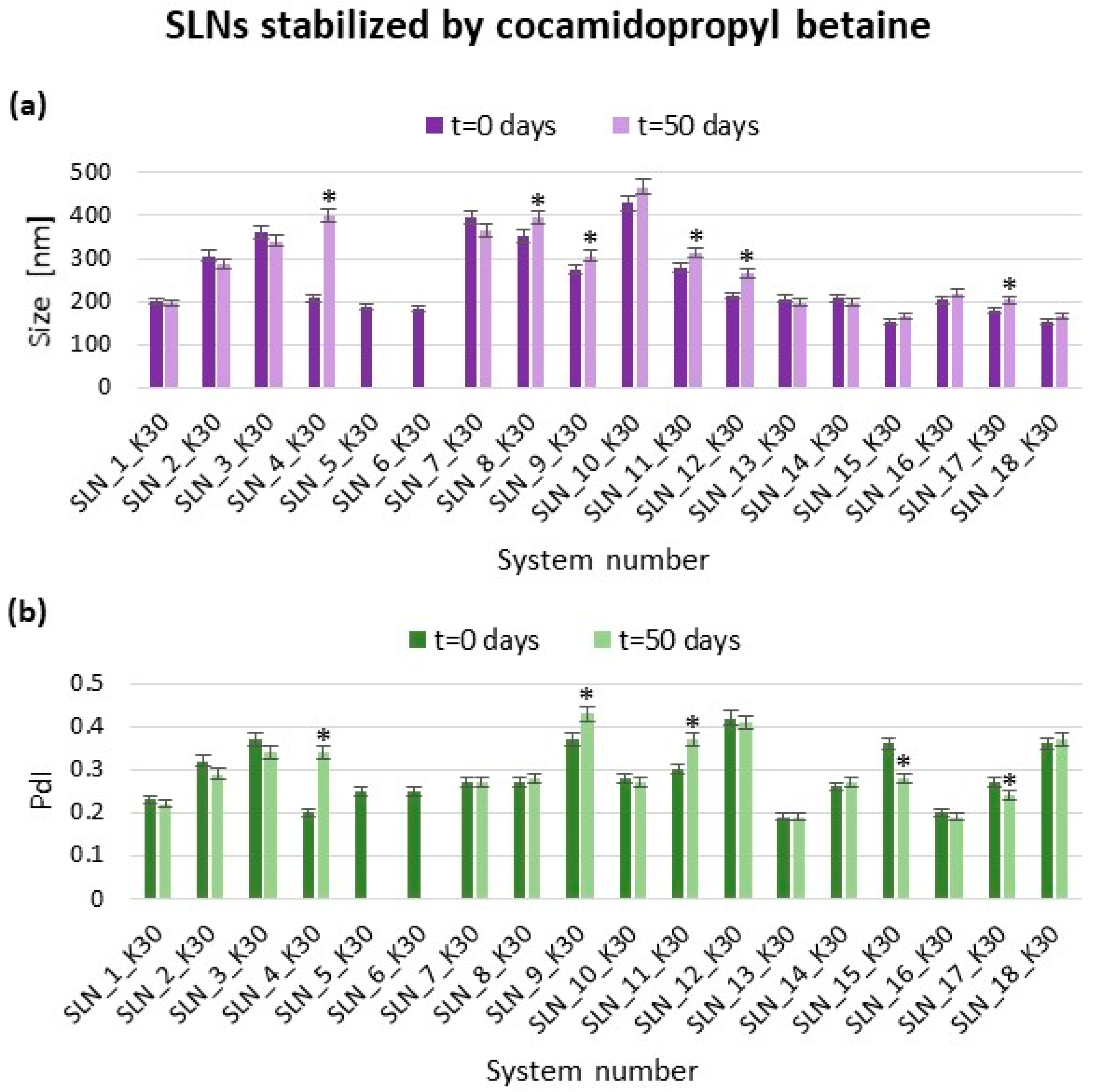
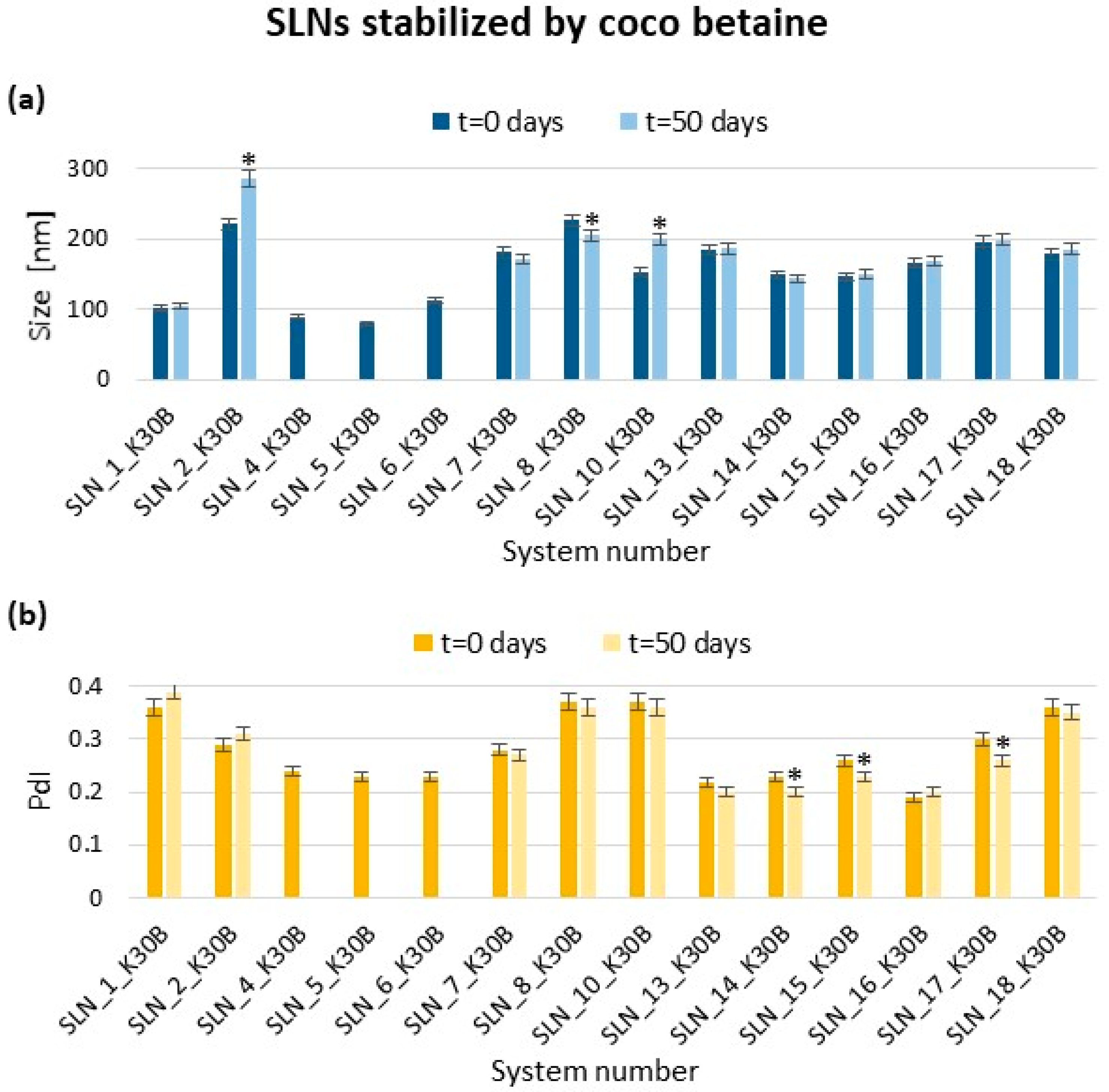

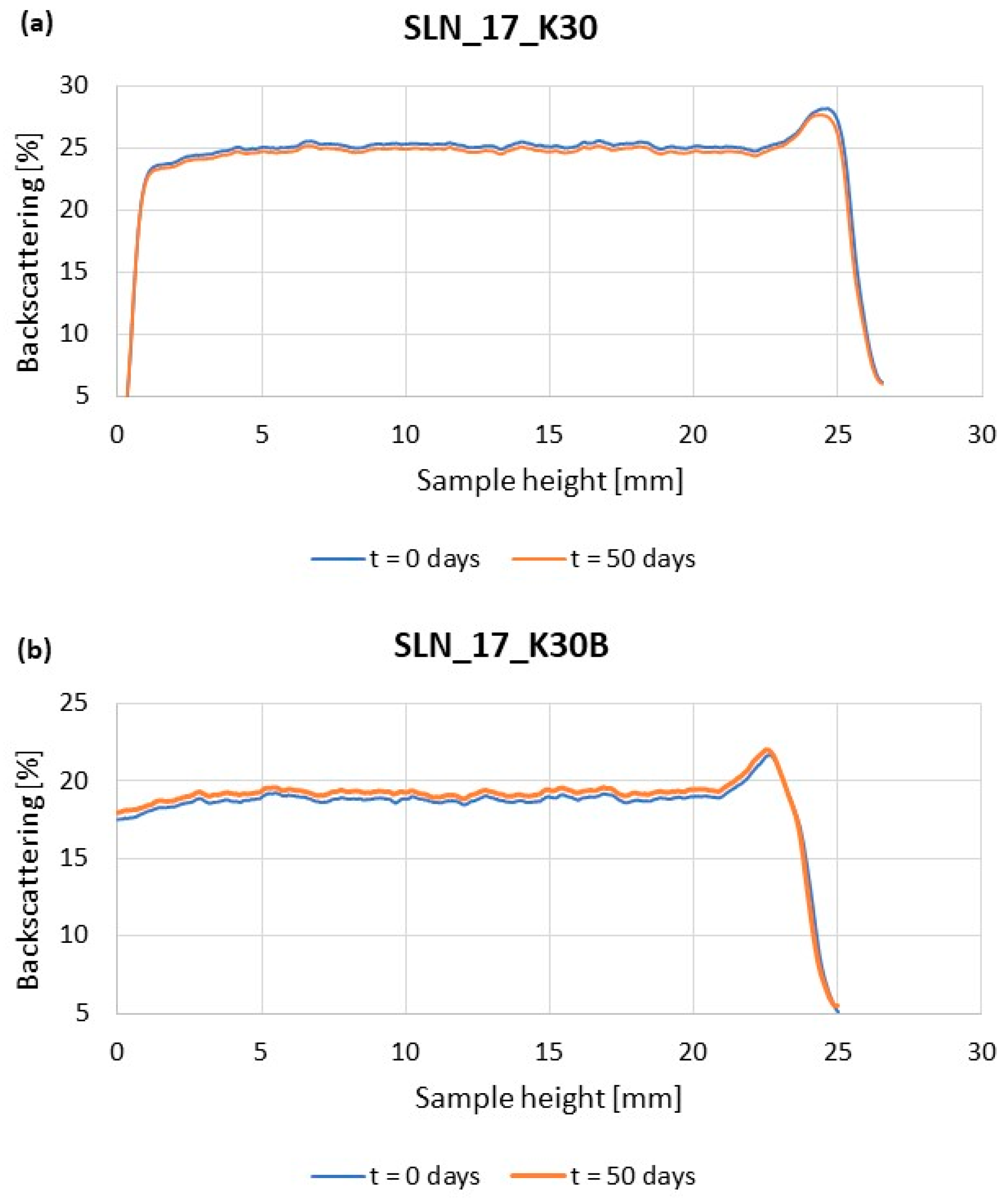
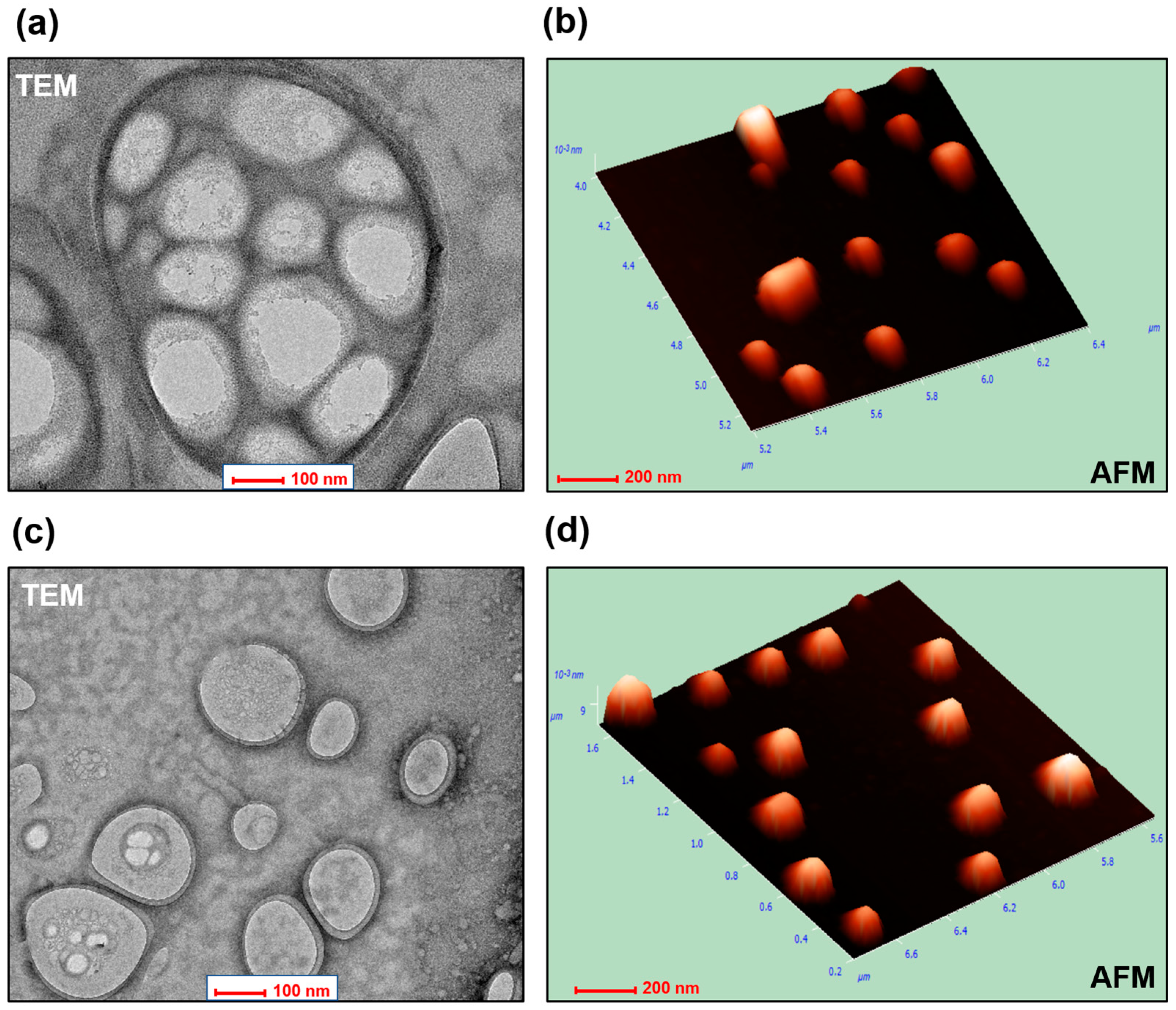
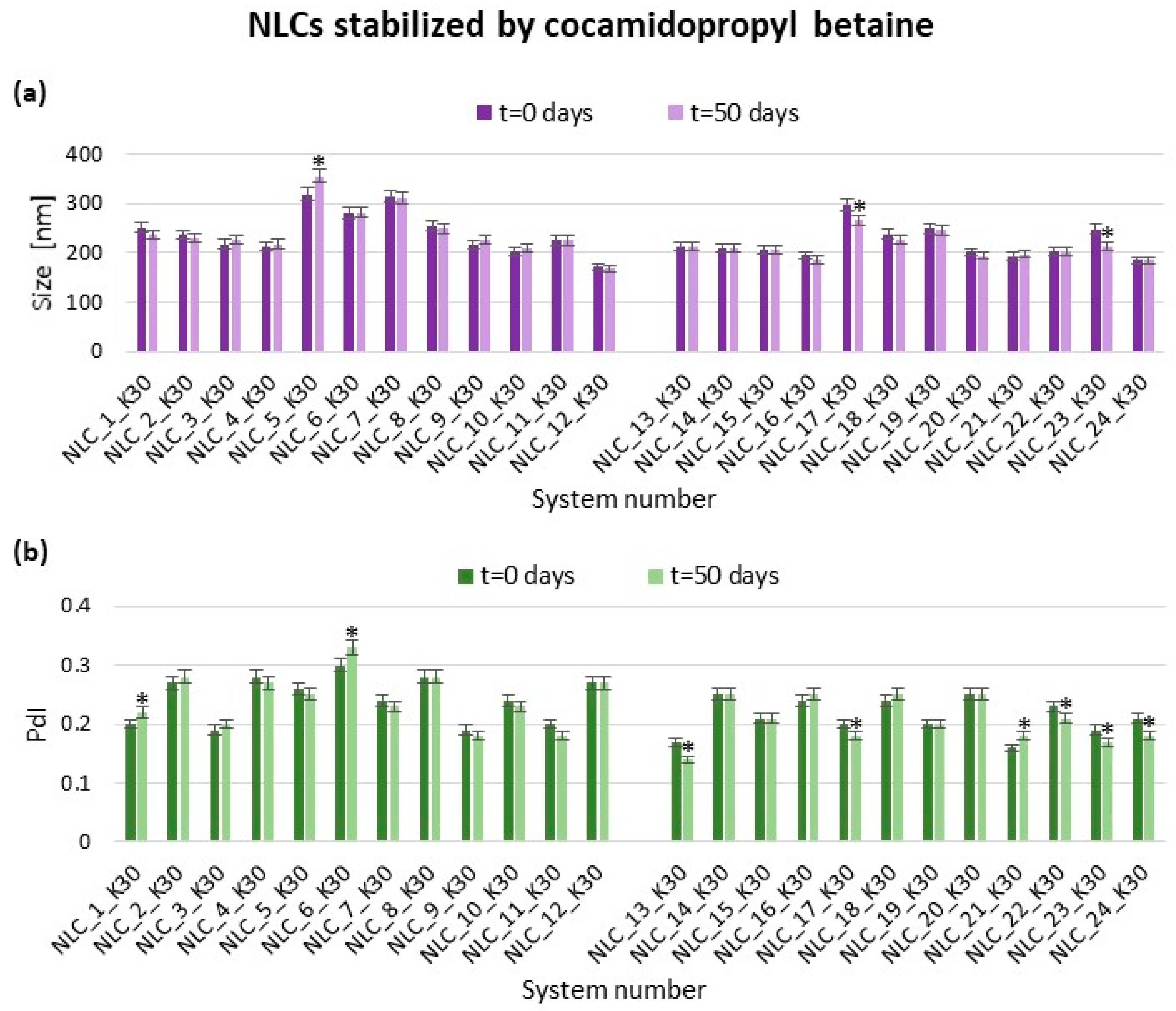
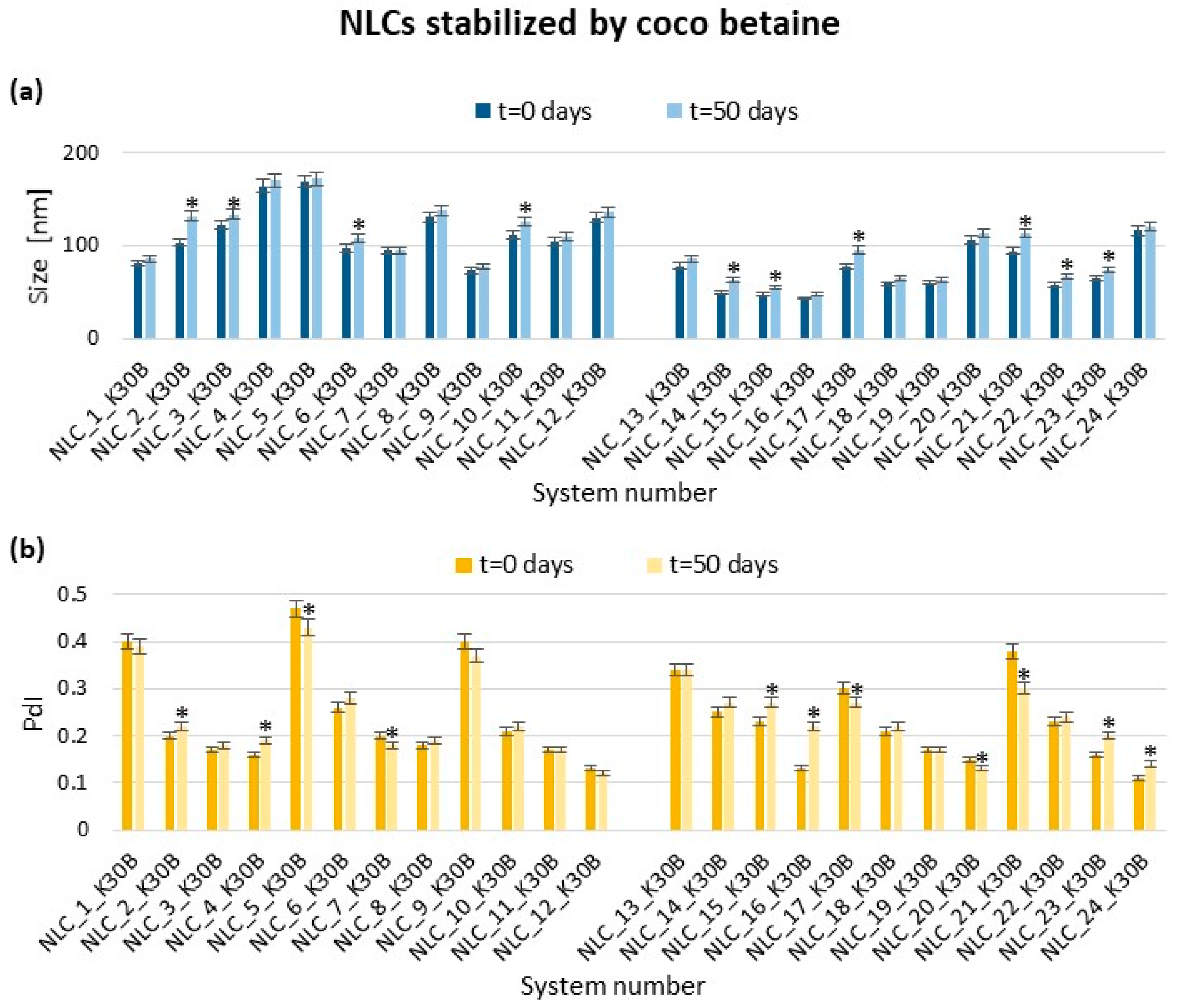

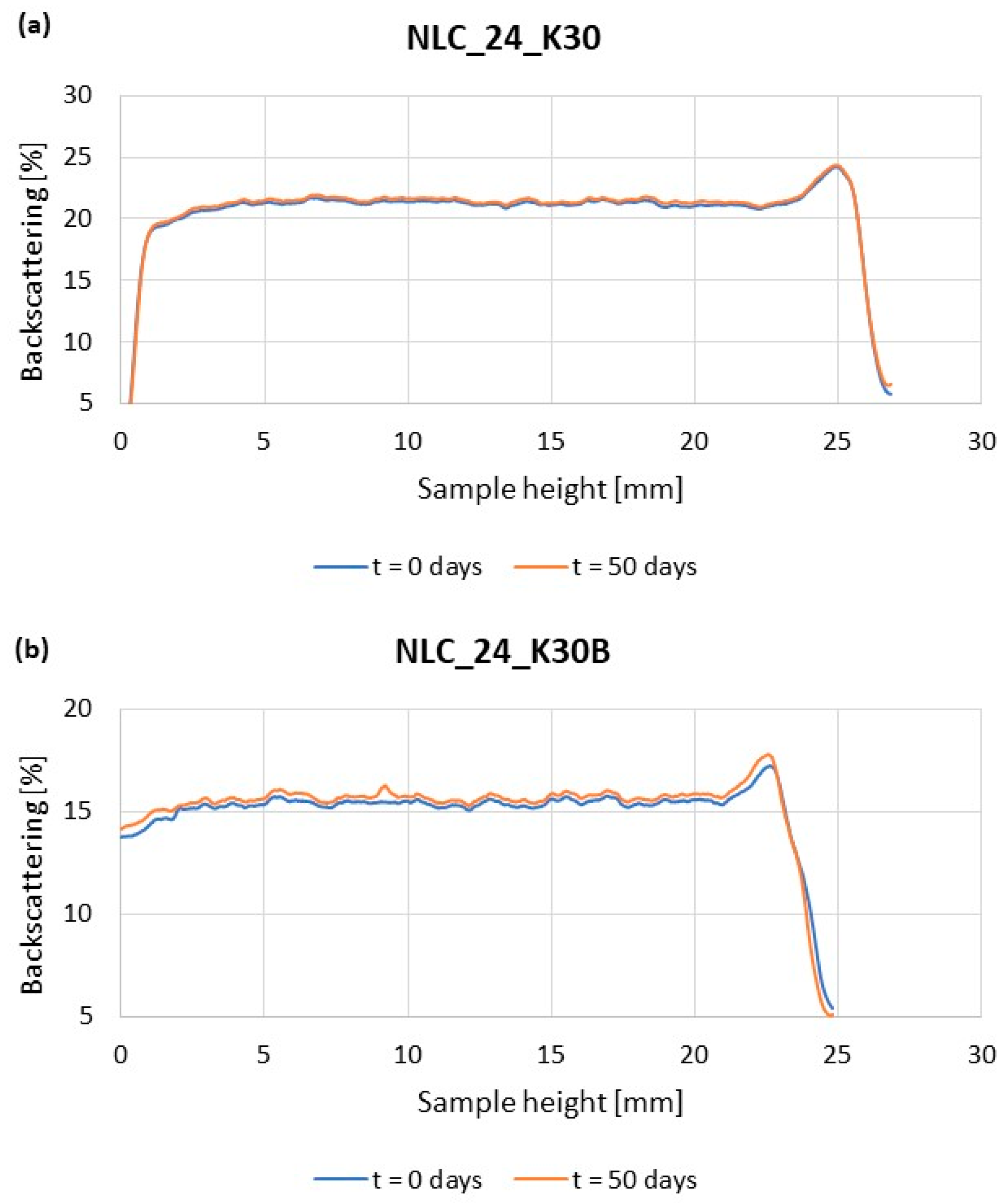

| Sample Abbreviation * | Type of Lipid | Lipid Concentration | Type of Surfactant | Surfactant Concentration |
|---|---|---|---|---|
| SLN_1_K30 | Dynasan 114 | 1% | ROKAmina K30 | 2% |
| SLN_2_K30 | Dynasan 114 | 2% | ROKAmina K30 | 2% |
| SLN_3_K30 | Dynasan 114 | 3% | ROKAmina K30 | 2% |
| SLN_4_K30 | Dynasan 114 | 1% | ROKAmina K30 | 1% |
| SLN_5_K30 | Dynasan 114 | 2% | ROKAmina K30 | 1% |
| SLN_6_K30 | Dynasan 114 | 3% | ROKAmina K30 | 1% |
| SLN_7_K30 | Dynasan 118 | 1% | ROKAmina K30 | 2% |
| SLN_8_K30 | Dynasan 118 | 2% | ROKAmina K30 | 2% |
| SLN_9_K30 | Dynasan 118 | 3% | ROKAmina K30 | 2% |
| SLN_10_K30 | Dynasan 118 | 1% | ROKAmina K30 | 1% |
| SLN_11_K30 | Dynasan 118 | 2% | ROKAmina K30 | 1% |
| SLN_12_K30 | Dynasan 118 | 3% | ROKAmina K30 | 1% |
| SLN_13_K30 | CRODAMOL CP | 1% | ROKAmina K30 | 2% |
| SLN_14_K30 | CRODAMOL CP | 2% | ROKAmina K30 | 2% |
| SLN_15_K30 | CRODAMOL CP | 3% | ROKAmina K30 | 2% |
| SLN_16_K30 | CRODAMOL CP | 1% | ROKAmina K30 | 1% |
| SLN_17_K30 | CRODAMOL CP | 2% | ROKAmina K30 | 1% |
| SLN_18_K30 | CRODAMOL CP | 3% | ROKAmina K30 | 1% |
| Sample Abbreviation * | Type of Lipid | Lipid Concentration | Type of Surfactant | Surfactant Concentration |
|---|---|---|---|---|
| solid lipid: liquid oil ratio = 8:2 | ||||
| NLC_1_K30 | Dynasan 114 | 1% | ROKAmina K30 | 2% |
| NLC_2_K30 | Dynasan 114 | 2% | ROKAmina K30 | 2% |
| NLC_3_K30 | Dynasan 114 | 1% | ROKAmina K30 | 1% |
| NLC_4_K30 | Dynasan 114 | 2% | ROKAmina K30 | 1% |
| NLC_5_K30 | Dynasan 118 | 1% | ROKAmina K30 | 2% |
| NLC_6_K30 | Dynasan 118 | 2% | ROKAmina K30 | 2% |
| NLC_7_K30 | Dynasan 118 | 1% | ROKAmina K30 | 1% |
| NLC_8_K30 | Dynasan 118 | 2% | ROKAmina K30 | 1% |
| NLC_9_K30 | CRODAMOL CP | 1% | ROKAmina K30 | 2% |
| NLC_10_K30 | CRODAMOL CP | 2% | ROKAmina K30 | 2% |
| NLC_11_K30 | CRODAMOL CP | 1% | ROKAmina K30 | 1% |
| NLC_12_K30 | CRODAMOL CP | 2% | ROKAmina K30 | 1% |
| solid lipid: liquid oil ratio = 6:4 | ||||
| NLC_13_K30 | Dynasan 114 | 1% | ROKAmina K30 | 2% |
| NLC_14_K30 | Dynasan 114 | 2% | ROKAmina K30 | 2% |
| NLC_15_K30 | Dynasan 114 | 1% | ROKAmina K30 | 1% |
| NLC_16_K30 | Dynasan 114 | 2% | ROKAmina K30 | 1% |
| NLC_17_K30 | Dynasan 118 | 1% | ROKAmina K30 | 2% |
| NLC_18_K30 | Dynasan 118 | 2% | ROKAmina K30 | 2% |
| NLC_19_K30 | Dynasan 118 | 1% | ROKAmina K30 | 1% |
| NLC_20_K30 | Dynasan 118 | 2% | ROKAmina K30 | 1% |
| NLC_21_K30 | CRODAMOL CP | 1% | ROKAmina K30 | 2% |
| NLC_22_K30 | CRODAMOL CP | 2% | ROKAmina K30 | 2% |
| NLC_23_K30 | CRODAMOL CP | 1% | ROKAmina K30 | 1% |
| NLC_24_K30 | CRODAMOL CP | 2% | ROKAmina K30 | 1% |
Disclaimer/Publisher’s Note: The statements, opinions and data contained in all publications are solely those of the individual author(s) and contributor(s) and not of MDPI and/or the editor(s). MDPI and/or the editor(s) disclaim responsibility for any injury to people or property resulting from any ideas, methods, instructions or products referred to in the content. |
© 2024 by the authors. Licensee MDPI, Basel, Switzerland. This article is an open access article distributed under the terms and conditions of the Creative Commons Attribution (CC BY) license (https://creativecommons.org/licenses/by/4.0/).
Share and Cite
Pucek-Kaczmarek, A.; Celary, D.; Bazylińska, U. Natural-Origin Betaine Surfactants as Promising Components for the Stabilization of Lipid Carriers. Int. J. Mol. Sci. 2024, 25, 955. https://doi.org/10.3390/ijms25020955
Pucek-Kaczmarek A, Celary D, Bazylińska U. Natural-Origin Betaine Surfactants as Promising Components for the Stabilization of Lipid Carriers. International Journal of Molecular Sciences. 2024; 25(2):955. https://doi.org/10.3390/ijms25020955
Chicago/Turabian StylePucek-Kaczmarek, Agata, Dominika Celary, and Urszula Bazylińska. 2024. "Natural-Origin Betaine Surfactants as Promising Components for the Stabilization of Lipid Carriers" International Journal of Molecular Sciences 25, no. 2: 955. https://doi.org/10.3390/ijms25020955
APA StylePucek-Kaczmarek, A., Celary, D., & Bazylińska, U. (2024). Natural-Origin Betaine Surfactants as Promising Components for the Stabilization of Lipid Carriers. International Journal of Molecular Sciences, 25(2), 955. https://doi.org/10.3390/ijms25020955







